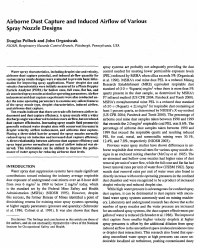 |
Water spray characteristics, including droplet size and velocity, airborne dust capture potential, and induced airflow quantity for various spray nozzle designs were evaluated to provide basic information for improving spray applications. Water droplet size and velocity characteristics were initially measured by a Phase Doppler Particle Analyzer (PDPA) for hollow cone, full cone, flat fan, and air atomized spray nozzles at similar operating parameters. Airflow inducement and dust capture experiments were also conducted under the same operating parameters to examine any salient features of the spray nozzle type, droplet characteristics, induced airflow, and airborne dust capture. Test results indicate that there are trade offs between airflow inducement and dust capture efficiency. A spray nozzle with a wider discharge angle was observed to induce more airflow, but at reduced dust capture efficiencies. Increasing spray nozzle fluid pressure(s) generally reduced water droplet sizes with concurrent increases in droplet velocity, airflow inducement, and airborne dust capture. Placing a three-sided barrier around the spray nozzles normally reduced spray air induction and increased dust capture efficiency. A direct relationship between airborne dust capture efficiency and spray input power normalized per unit of airflow induced was observed. This information can be utilized to improve the performance of water sprays for reducing airborne dust levels.
| Author(s): | Pollock-DE, Organiscak-JA |
| Reference: | Aerosol Sci Tech 2007 Jul; 41(7):711–720 |
adcai (PDF, 1837 KB)